3/4 guitars have been growing in popularity in recent years. Some people might be wondering what the difference is between 3/4 and full-size guitars and which one they should choose.
In this article, we’ll compare 3/4 guitar vs full-size guitar and help you decide which one is right for you.
3/4 Guitar vs Full Size: How Do They Compare?
Features Of A ¾ Guitar
Since it is better matched to their height, a ¾ guitar is a wonderful choice for kids between the ages of 8 and 12 who are just beginning to play the guitar.
Many adults find playing a ¾ guitar to be more comfortable, especially if they find difficulty reaching deeper upper frets and tones on normal size guitars.
It also is important to keep in mind that a ¾ guitar has the same components as a full-size guitar, so switching to a smaller instrument won’t change your playing experience.
Main Features:
- The body of the ¾ guitar model is made of mahogany.
- The scale is 21 to 24 inches long.
- The neck has no more than 18 frets.
- Neck material is produced in okume, rosewood, and maple.
- A headstock holds tuning pegs on all ¾ guitars.
- ¾ guitars are usually used as practice instruments.
The length of a ¾ guitar depends on the model; however, it should not exceed 36 inches as a general guideline. A ¾ guitar’s body is normally roughly 13 inches wide; however, if a guitar’s body is broader than that, it isn’t a ¾ guitar.
There are practically no variations in the appearance of the bodies of ¾ and full-size guitars; thus, distinguishing between them is difficult until you compare their sizes.
A ¾ guitar’s body, neck, as well as other components are identical to those found on a full-size guitar. As a result, knowing which aspects of a ¾ guitar can increase its playability will make it simpler to pick one.
How long a ¾ guitar model will last is based on how often you play it and how well you maintain it. Also, if you’re just starting out, you shouldn’t spend too much on a ¾ guitar because you can upgrade to a full-size guitar as you gain experience.
Features Of A Full-Size Guitar
What is the standard guitar size? This is a hotly disputed topic that has no conclusive answer. The dimensions of so-called 4/4 guitars vary by manufacturer, although most are roughly 40 inches long.
Headless guitars are the exception since these electric guitars have a built-in tuner instead of a headstock with tuning pegs. As a result, they are smaller than full-size guitars, yet this has no bearing on their tone or playability.
Selecting a full-size guitar merely on the basis of its size is challenging because there are other factors to consider.
Main Features:
- Single, double, or non-cutaway bodies are available.
- The majority of models are 40 x 15 inches in size.
- The scale is more than 24 inches in length
- There are more than 19 frets on the neck.
- The materials used to construct the neck and body vary by model and manufacturer.
- The guitar’s string size compatibility varies.
Full-size guitars can cost anywhere from a few hundred to a few thousand dollars. The Yamaha C40 is a standard instrument that is 40 inches long and 15 inches broad, making it appropriate for players taller than 5 feet.
Furthermore, the 25.59-inch scale of this traditional full-size guitar provides higher string tension. The bodies of 4/4 classical and acoustic guitars might not have cutaways, making them seem identical to their 3/4 counterparts.
Such guitars’ necks contain more frets, allowing for more tonal variety, yet the bigger height and thickness of the neck might make hitting low notes harder for players with short fingers.
As full-size guitars maintain string pressure, they are less prone to go out of tune fast than 3/4 instruments. Even so, if you want to get the most out of your speakers, you must adjust them on a regular basis.
When buying a full-size guitar, pay attention to elements like the bridge, tuning system, and truss rod. For players who desire to go from a 3/4 to a 4/4 guitar, a model like the Yamaha C40 would be a viable option.
Who Wins?
When it comes to 3/4 guitar vs full size, 3/4 models are more comfortable for beginners and small-framed individuals. On the other hand, full-size guitars offer more tone options and are less likely to fall out of tune. 3/4 guitars are, therefore, ideal for beginners, while full-size models are more appropriate for experienced players.



